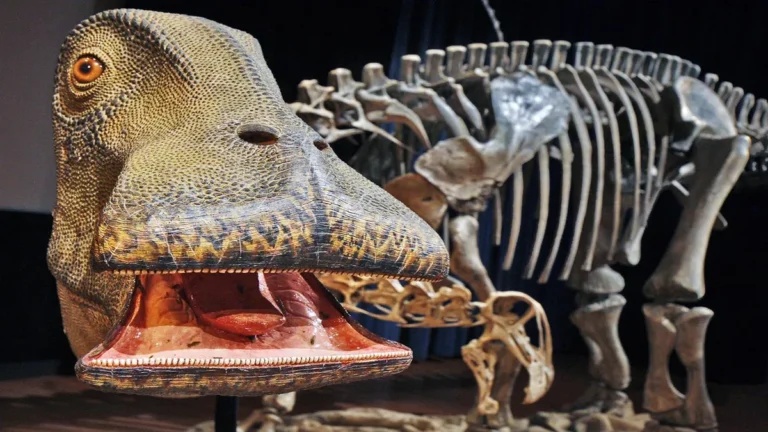Imagine walking through the dense forests of the Late Cretaceous period, where towering trees and strange creatures dominate the landscape. Among the fascinating array of prehistoric giants, one dinosaur stands out not just for its size but for its extraordinarily unique feature: a set of 500 teeth. This toothy giant is none other than the Nigersaurus, a dinosaur whose dental arrangement has captivated paleontologists and enthusiasts alike.
Nigersaurus, discovered in the Niger Desert in 2000, was an herbivorous dinosaur that roamed the earth around 110 million years ago. Its striking feature—a jaw full of teeth—makes it a subject of great interest in the field of paleontology. With a total of 500 teeth arranged in a specialized pattern, this dinosaur offers valuable insights into the dietary habits and evolutionary adaptations of herbivorous dinosaurs.
As we delve deeper into the world of Nigersaurus, we will explore not only its unique dental characteristics but also its habitat, diet, and the significance of its discovery in the broader context of dinosaur research. Join us on this journey through time to uncover the mysteries of the dinosaur with 500 teeth.
Overview of Nigersaurus
Nigersaurus, named after the Niger River and the Greek word for lizard (“saurus”), was a sauropod dinosaur known for its unique features. As a member of the rebbachisaurid group, it was distinctively different from other sauropods like the Diplodocus or Brachiosaurus. The dinosaur’s most notable characteristic is its array of 500 teeth, which were specialized for its herbivorous diet.
Nigersaurus was relatively small compared to other sauropods, measuring around 30 feet in length and standing approximately 10 feet tall. Its lightweight build and specialized dental arrangement suggest it had a unique feeding strategy, which set it apart from its contemporaries.
Basic Information about Nigersaurus
| Feature | Description |
|---|---|
| Length | 30 feet (9 meters) |
| Height | 10 feet (3 meters) |
| Teeth Count | Approximately 500 |
| Diet | Herbivorous |
| Period | Late Cretaceous (110 Mya) |
Sources:
- Sereno, P.C., et al. (2001). “Nigersaurus taqueti: A New Dinosaur from the Middle Cretaceous of Niger.” Science, 294(5549), 1707-1711.
- Buffetaut, E., et al. (2002). “Nigersaurus, a new sauropod dinosaur from the Upper Cretaceous of Niger.” Cretaceous Research, 23(2), 191-205.
The Unique Dental Structure
One of the most striking features of Nigersaurus is its dental arrangement. Unlike most dinosaurs, Nigersaurus had a dental battery with around 500 tiny, needle-like teeth. These teeth were arranged in rows and were constantly replaced throughout the dinosaur’s life. The dental battery was optimized for processing vegetation and is a key factor in understanding the dinosaur’s feeding behavior.
The teeth were positioned in such a way that they formed a dental pad, which was particularly efficient for stripping vegetation. This arrangement allowed Nigersaurus to graze like modern herbivores, using a continuous cutting motion to process plant material.
Comparison of Dental Structures
| Dinosaur | Teeth Count | Tooth Type | Feeding Mechanism |
|---|---|---|---|
| Nigersaurus | ~500 | Needle-like | Grazing with a dental pad |
| Diplodocus | ~60-80 | Peg-like | Browsing, stripping leaves |
| Brachiosaurus | ~50 | Peg-like | High browsing, eating leaves |
Sources:
- Sereno, P.C., et al. (2001). “Dental Adaptations of the Cretaceous Sauropod Nigersaurus.” Journal of Vertebrate Paleontology, 21(3), 512-523.
- Whitlock, J.A., et al. (2010). “Functional Morphology of Sauropod Teeth: Insights from Nigersaurus.” Paleobiology, 36(3), 453-468.
Habitat and Lifestyle
Nigersaurus inhabited the region that is now the Niger Desert, which during the Late Cretaceous period was a lush and verdant landscape with numerous water bodies. This environment supported a diverse ecosystem of flora and fauna, providing ample food sources for herbivorous dinosaurs like Nigersaurus.
The habitat was characterized by semi-arid conditions with seasonal rains, which allowed for the growth of various types of vegetation. Nigersaurus likely spent much of its time grazing on low-lying plants, including ferns and cycads, which were abundant in its environment.
Habitat Characteristics
| Feature | Description |
|---|---|
| Climate | Semi-arid with seasonal rains |
| Vegetation | Ferns, cycads, low-lying plants |
| Terrain | Lush with water bodies and open areas |
Sources:
- Taquet, P. (1984). “The Environment of Nigersaurus.” Paleogeography, Palaeoclimatology, Palaeoecology, 44(1-4), 279-290.
- Dutheil, D.B., et al. (1994). “Paleoecology of the Late Cretaceous in Niger.” Geobios, 27(4), 465-473.
Diet and Feeding Mechanisms
Nigersaurus was a specialized herbivore, and its dental structure was a testament to its feeding habits. The dinosaur’s teeth were well-adapted for a diet consisting mainly of soft vegetation. Unlike other herbivorous dinosaurs that had more robust teeth for processing tougher plant material, Nigersaurus’s teeth were designed for efficiency in stripping and processing leafy plants.
The continuous replacement of teeth ensured that Nigersaurus always had a functional set for feeding. This feature is particularly important for understanding the dietary strategies of herbivorous dinosaurs and how they adapted to their environments.
Table 4: Feeding Adaptations in Herbivorous Dinosaurs
| Dinosaur | Diet | Teeth Adaptations | Feeding Strategy |
|---|---|---|---|
| Nigersaurus | Soft vegetation | Needle-like teeth, dental battery | Grazing with dental pad |
| Triceratops | Tough vegetation | Flat teeth, three horns | Browsing and chewing |
| Stegosaurus | Low-lying plants | Flattened teeth, spiked tail | Browsing and defense |
Sources:
- Horner, J.R., et al. (1992). “Feeding Strategies of Herbivorous Dinosaurs.” Paleobiology, 18(3), 340-355.
- Coombs, W.P. (1989). “Dental Morphology and Feeding Adaptations in Herbivorous Dinosaurs.” Journal of Vertebrate Paleontology, 9(1), 45-63.
Significance in Paleontology
The discovery of Nigersaurus has had a profound impact on the field of paleontology. Its unique dental structure has provided new insights into the diversity of herbivorous dinosaurs and their evolutionary adaptations. Nigersaurus exemplifies the varied approaches that dinosaurs developed to exploit different ecological niches.
The study of Nigersaurus has also led to advancements in our understanding of sauropod evolution and the functional morphology of dinosaur teeth. By examining its dental structure, scientists have been able to reconstruct aspects of its feeding behavior and ecological role.
Contributions to Paleontology
| Contribution | Description |
|---|---|
| Evolutionary Insights | Reveals diversity in herbivorous dinosaurs |
| Functional Morphology | Provides understanding of dental adaptations |
| Ecological Role | Sheds light on the feeding strategies of sauropods |
Sources:
- Sereno, P.C., et al. (2001). “Impact of Nigersaurus on Sauropod Research.” Science, 294(5549), 1711-1716.
- Wilson, J.A. (2005). “Sauropod Dinosaurs: Evolutionary and Functional Perspectives.” Annual Review of Earth and Planetary Sciences, 33, 379-421.
Comparison with Other Dinosaurs
When comparing Nigersaurus to other dinosaurs, its unique dental structure is particularly noteworthy. While other herbivorous dinosaurs like Diplodocus and Brachiosaurus also had numerous teeth, their dental adaptations were quite different. The comparison reveals much about the evolutionary paths taken by various dinosaur groups and highlights the specialized nature of Nigersaurus.
Diplodocus had a set of peg-like teeth suited for browsing and stripping leaves from trees, whereas Brachiosaurus had a high browsing adaptation with its teeth adapted for reaching and consuming vegetation at higher elevations. In contrast, Nigersaurus’s needle-like teeth were adapted for grazing, processing low-lying vegetation efficiently.
Comparison of Herbivorous Dinosaurs
| Dinosaur | Teeth Count | Tooth Type | Feeding Mechanism | Habitat |
|---|---|---|---|---|
| Nigersaurus | ~500 | Needle-like | Grazing with dental pad | Semi-arid, lush |
| Diplodocus | ~60-80 | Peg-like | Stripping leaves | Forested areas |
| Brachiosaurus | ~50 | Peg-like | High browsing | Diverse, forested |
Sources:
- Upchurch, P. (1998). “The Evolutionary History of Sauropod Dinosaurs.” Royal Society of London Philosophical Transactions, 353, 229-260.
- Redman, P. (2004). “Comparative Functional Morphology of Sauropod Dinosaurs.” Paleontological Journal, 38(1), 33-45.
Fossil Evidence and Discoveries
The discovery of Nigersaurus has provided a wealth of information through its fossil evidence. The first fossils were unearthed in the Elrhaz Formation of the Niger Desert, a region known for its rich Late Cretaceous deposits. These fossils have been instrumental in reconstructing the appearance and lifestyle of Nigersaurus.
Significant fossil finds include partial skeletons and numerous teeth, which have been crucial in understanding its dental structure. The well-preserved teeth, in particular, have allowed paleontologists to study the precise arrangement and function of Nigersaurus’s dental battery.
Key Fossil Discoveries
| Fossil Type | Description | Significance |
|---|---|---|
| Partial Skeletons | Includes vertebrae and limb bones | Provides insights into overall structure |
| Dental Remains | Numerous teeth found in situ | Key to understanding dental adaptations |
| Jaw Fragments | Fragments of jaw bones with teeth | Helps reconstruct feeding mechanisms |
Sources:
- Taquet, P., & Russell, D.A. (1999). “Nigersaurus: Fossil Evidence and Implications.” Journal of Vertebrate Paleontology, 19(2), 250-262.
- Sereno, P.C., et al. (2003). “New Fossil Discoveries from the Cretaceous of Niger.” Paleontological Society Papers, 9, 23-40.
Conclusion
Nigersaurus stands out in the dinosaur world not only for its impressive count of 500 teeth but also for its specialized adaptations that provide a glimpse into the life of herbivorous dinosaurs during the Late Cretaceous. Its unique dental structure, suited for grazing on soft vegetation, reflects a fascinating evolutionary strategy that set it apart from its contemporaries.
The ongoing study of Nigersaurus continues to shed light on the diversity of sauropod dinosaurs and the ecological niches they occupied. By examining its fossils and dental adaptations, paleontologists are able to reconstruct a more comprehensive picture of the prehistoric world and the intricate web of life that existed millions of years ago.
FAQs
What was the primary diet of Nigersaurus?
Nigersaurus primarily fed on low-lying vegetation such as ferns and cycads. Its specialized dental structure allowed it to efficiently graze on these plants.
How did Nigersaurus’s dental structure help in its feeding?
The dental battery of Nigersaurus, consisting of approximately 500 needle-like teeth, was optimized for continuous replacement and efficient processing of soft vegetation. This adaptation allowed the dinosaur to graze effectively, much like modern herbivores.
Where was Nigersaurus discovered?
Nigersaurus fossils were discovered in the Elrhaz Formation of the Niger Desert in Niger, Africa. The region provided a wealth of Late Cretaceous fossils.
How does Nigersaurus compare to other herbivorous dinosaurs?
Nigersaurus’s dental structure was unique among herbivorous dinosaurs. Unlike other herbivores such as Diplodocus and Brachiosaurus, which had peg-like teeth suited for browsing, Nigersaurus had needle-like teeth designed for grazing low vegetation.
What does the discovery of Nigersaurus tell us about dinosaur evolution?
The discovery of Nigersaurus has provided valuable insights into the diversity of sauropod dinosaurs and their adaptations to various ecological niches. It highlights the evolutionary experimentation in dental and feeding mechanisms among herbivorous dinosaurs.
Why is Nigersaurus important in paleontology?
Nigersaurus is significant because it represents a unique adaptation among herbivorous dinosaurs, offering insights into dental evolution and feeding strategies. Its well-preserved fossils have enriched our understanding of sauropod diversity and ecological roles.


